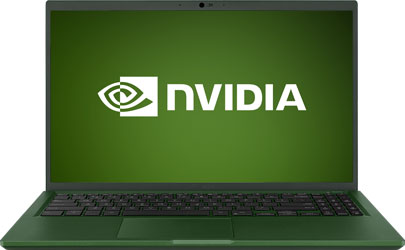Report an Error
NVIDIA GeForce RTX 3070 Ti Max-Q
- Graphics Processor
- GA104
- Cores
- 5888
- TMUs
- 184
- ROPs
- 96
- Memory Size
- 8 GB
- Memory Type
- GDDR6
- Bus Width
- 256 bit
Recommended Gaming Resolutions:
- 1920x1080
- 2560x1440
- 3840x2160
The GeForce RTX 3070 Ti Max-Q is a mobile graphics chip by NVIDIA, launched on January 4th, 2022. Built on the 8 nm process, and based on the GA104 graphics processor, the chip supports DirectX 12 Ultimate. This ensures that all modern games will run on GeForce RTX 3070 Ti Max-Q. Additionally, the DirectX 12 Ultimate capability guarantees support for hardware-raytracing, variable-rate shading and more, in upcoming video games. The GA104 graphics processor is a large chip with a die area of 392 mm² and 17,400 million transistors. Unlike the fully unlocked GeForce RTX 3070 Ti, which uses the same GPU but has all 6144 shaders enabled, NVIDIA has disabled some shading units on the GeForce RTX 3070 Ti Max-Q to reach the product's target shader count. It features 5888 shading units, 184 texture mapping units, and 96 ROPs. Also included are 184 tensor cores which help improve the speed of machine learning applications. The card also has 46 raytracing acceleration cores. NVIDIA has paired 8 GB GDDR6 memory with the GeForce RTX 3070 Ti Max-Q, which are connected using a 256-bit memory interface. The GPU is operating at a frequency of 510 MHz, which can be boosted up to 1035 MHz, memory is running at 1500 MHz (12 Gbps effective).
Its power draw is rated at 80 W maximum. This device has no display connectivity, as it is not designed to have monitors connected to it. Rather it is intended for use in laptop/notebooks and will use the output of the host mobile device. GeForce RTX 3070 Ti Max-Q is connected to the rest of the system using a PCI-Express 4.0 x16 interface.
Its power draw is rated at 80 W maximum. This device has no display connectivity, as it is not designed to have monitors connected to it. Rather it is intended for use in laptop/notebooks and will use the output of the host mobile device. GeForce RTX 3070 Ti Max-Q is connected to the rest of the system using a PCI-Express 4.0 x16 interface.
Graphics Processor
Mobile Graphics
- Release Date
- Jan 4th, 2022
- Availability
- Feb 1st, 2022
- Generation
- GeForce 30 Mobile
- Predecessor
- GeForce 20 Mobile
- Production
- Active
- Bus Interface
- PCIe 4.0 x16
Relative Performance
Based on TPU review data: "Performance Summary" at 1920x1080, 4K for 2080 Ti and faster.
Performance estimated based on architecture, shader count and clocks.
Clock Speeds
- Base Clock
- 510 MHz
- Boost Clock
- 1035 MHz
- Memory Clock
-
1500 MHz
12 Gbps effective
Memory
- Memory Size
- 8 GB
- Memory Type
- GDDR6
- Memory Bus
- 256 bit
- Bandwidth
- 384.0 GB/s
Render Config
- Shading Units
- 5888
- TMUs
- 184
- ROPs
- 96
- SM Count
- 46
- Tensor Cores
- 184
- RT Cores
- 46
- L1 Cache
- 128 KB (per SM)
- L2 Cache
- 4 MB
Theoretical Performance
- Pixel Rate
- 99.36 GPixel/s
- Texture Rate
- 190.4 GTexel/s
- FP16 (half)
- 12.19 TFLOPS (1:1)
- FP32 (float)
- 12.19 TFLOPS
- FP64 (double)
- 190.4 GFLOPS (1:64)
Board Design
- TDP
- 80 W
- Outputs
- Portable Device Dependent
- Power Connectors
- None
- Board Number
- E4735 SKU 10
Graphics Features
- DirectX
- 12 Ultimate (12_2)
- OpenGL
- 4.6
- OpenCL
- 3.0
- Vulkan
- 1.3
- CUDA
- 8.6
- Shader Model
- 6.8
GA104 GPU Notes
| Ray Tracing Cores: 2nd Gen Tensor Cores: 3rd Gen NVENC: 7th Gen NVDEC: 5th Gen PureVideo HD: VP11 VDPAU: Feature Set K Latest Drivers: Windows 7 / 8 / 8.1 (x64): GeForce Release 474.89 Windows 10 / 11 (x64): GeForce Release: Latest Quadro Release: Latest Data Center Release: Latest |
Nov 17th, 2024 07:21 EST
change timezone
Latest GPU Drivers
New Forum Posts
- Dream Monitor Ideas (152)
- What are you playing? (22212)
- RX 580 2048sp 8gb Problems (32)
- Your PC ATM (35021)
- Page loading issues from Russia (37)
- Why Elden Ring doesn't impress me. Innovation in combat physics is needed in the gaming industry. (43)
- Tatty One should Come Out of Retirement (160)
- ASUS RTX 4070 TUF possible in Omen 880-181 nf ?? (0)
- Last game you purchased? (516)
- Graphic card holder. So the fans points upwards. (3)
Popular Reviews
- NVIDIA App v1.0 Review
- AMD Ryzen 7 9800X3D Review - The Best Gaming Processor
- Epomaker TH40 Wireless Mechanical Keyboard Review
- Redragon K1NG 8K Review
- Beelink GTi12 Ultra Mini-PC + EX Dock (Intel Core i9-12900H) Review
- Valkyrie VK02 Lite Review
- Quick Look: MOONDROP Quark2 Type-C In-Ear Monitors
- Quick Look: G.SKILL WigiDash PC Command Panel
- Upcoming Hardware Launches 2024 (Updated Nov 2024)
- NVIDIA GeForce RTX 4070 Super Founders Edition Review
Controversial News Posts
- AMD Falling Behind: Radeon dGPUs Absent from Steam's Top 20 (222)
- AMD Ryzen 7 9800X3D Stocks Vaporized in Retail, Being Scalped (151)
- AMD Introduces Next-Generation AMD Ryzen 7 9800X3D Processor, $479, Nov 7 (124)
- Apple and Samsung in the Fray to Acquire Intel: Rumor (123)
- AMD Ryzen 7 9800X3D Comes with 120W TDP, 5.20 GHz Boost, All Specs Leaked (120)
- Microsoft Offers $30 Windows 10 Security Extension for Home Users (118)
- AMD Ryzen 7 9800X3D Has the CCD on Top of the 3D V-cache Die, Not Under it (110)
- TechPowerUp is Hiring a Power Supply (PSU) Reviewer (105)

